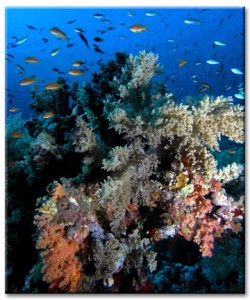Just say yes!
Coiba National Park off Panama’s Pacific coast encompasses the majority of the Gulf of Chiriqí’s continental shelf and 38 islands. White sand beaches, hardwood tropical forests, and unique ecological and marine diversity—including wildlife found nowhere else in the world—make these islands breath taking. Not only does Coiba’s natural beauty soothe the soul, the park is also a resource for healing the body.
Researchers participating in an innovative conservation program initiated at the Smithsonian Tropical Research Institute isolated more than 45 chemical compounds produced by marine creatures in Coiba that show great promise in fighting cancer, as well as malaria and other tropical diseases.
Plants, animals and microbes continually evolve new strategies to ensure survival, including the production of chemical compounds to help protect themselves from predators and disease. Scientists at the University of Panama have isolated a group of chemicals known as coibanoles from fungi growing inside the leaves of the plant Desmotes incomparabilis, which is found only on Coiba Island.
Researchers have found beneficial chemicals in corals, sponges, plants, fungi and bacteria associated with sea urchins, tunicates and fish. One source alone, the cyanobacteria—also known as blue-green algae—has yielded Coibamide A, a compound that is extremely effective against cancer cells; Veraguamide A, an anti-cancer compound named after the Panamanian province of Veraguas; and Santacruzmate, an anti-parasitic compound named after Santa Cruz island.
The Panama International Cooperative Biodiversity Group, initiated at STRI by researchers from the University of Utah, has become a new model for international drug discovery. In the past, bioprospecting projects often excluded the host country from the drug discovery process that includes collecting natural source materials, extracting chemical compounds, testing chemicals against disease organisms in a lab, animal testing and finally, drug patenting and marketing.
The ICBG program, funded by the U.S. National Institutes of Health, the U.S. National Science Foundation and the U.S. Department of Agriculture, promote s drug discovery, develops infrastructure, trains scientists, contributes to species lists and conservation initiatives, and provide s benefits to the host country, including intellectual property rights and monetary recompense in the event that a compound is developed as a pharmaceutical drug.
ICBG’s success in Panama would not have been possible had Panama not designated Coiba as a national park in 2004 (original plans called for development as a tourist attraction. STRI worked closely with the Panamanian government from the start of the process. Staff scientist Héctor Guzmán and colleagues provided much of the research about corals and other organisms unique to the area and marine biologist Juan Maté has coordinated the development of the new park management plan with several other local and international institutions. Coiba National Park was named a UNESCO World Heritage site in 2005.
Posted: 10 March 2011
-
Categories:
Feature Stories , Science and Nature , Tropical Research Institute







